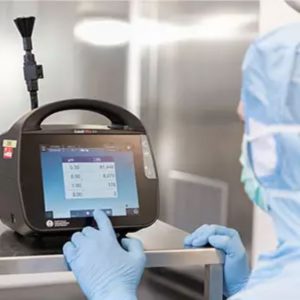Optical particle counters (OPCs) work by preserving the air quality of a cleanroom environment. To learn more about them, this article dives into OPC counting efficiency and resolution. Alongside this, it answers the key questions that you may consider when thinking about selecting and using OPCs.
The Basics of OPC Counting Efficiency
OPC counting efficiency refers to the probability of accurately sensing the size ranges of particles passing through a sample volume. In the language of ISO 14644, we tend to discuss light-scattering air particle counters (LSAPCs) rather than OPCs. But for ease of reading, we’ll stick to the OPC verbiage for this article. Thus, OPC counting efficiency describes the percentage of the number of particles counted at or above a specified size. The reliability of these results will depend on the flow rate that it detects.
A crucial aspect of this is the 50% counting efficiency at the most sensitive sizing threshold. This efficiency is significant because it represents the balance between detecting smaller particles and avoiding false positives. The counting efficiency is asymmetrical because of the exponential relationship between particle size and the scattered light signal.
Understanding OPC Resolution
An OPC’s resolution is its ability to distinguish between small differences in particle size. Several factors influence resolution, including the amount of light. The light source will affect the uniformity of illumination within the sampling volume. The quality of the optical system and the electronics in the Pulse Height Analyzer module will also affect the resolution. Therefore, it will be able to distinguish between small particles and any particles larger than what was anticipated.
High resolution in OPCs is crucial as it allows for a more accurate sizing of particles. This is essential in environments where even the most minute particles can impact the overall cleanliness.
The Impact of OPC Counting Efficiency and Resolution on Cleanroom Data
The control of airborne particles is crucial for maintaining the standards of cleanrooms. This includes product quality and how it adheres to industry standards. Therefore, the accuracy of particle counting data is extremely important. The counting efficiency and resolution of OPCs are critical factors directly influencing this data.
Particle Measurements and OPC Counting Efficiency
OPC counting efficiency plays a pivotal role in determining the sensitivity of particle measurement. This efficiency is particularly crucial at the most sensitive sizing threshold of the OPC.
Smaller yet significant particles could be missed if the counting efficiency is too low. This could potentially lead to the underestimation of contamination levels.
Conversely, an overly high efficiency can cause overcounting, including the appearance of false positives. This could create unnecessary alarms and disruptions in cleanroom operations. Therefore, achieving a balanced counting efficiency, typically 50% at the most sensitive threshold, is essential for reliable particle measurement.
Particle Sizes and OPC Resolution
OPC counting efficiency and resolution are equally important. The resolution refers to the instrument’s ability to distinguish between particles of different sizes. By ensuring a high resolution, it is easier to determine the particle size distribution with utmost precision. 
This is extremely important in environments where specific particle sizes can have varying impacts, such as semiconductor manufacturing. Different sizes of smaller and larger particles could end up causing damage during the production process.
An OPC with high resolution can accurately identify and quantify these specific particle sizes. This can allow for more targeted and effective cleanroom management. However, challenges arise when translating the resolution observed with monodispersed calibration particles, such as polystyrene latex spheres (PSLs), to real-world particle distributions.
The Challenges of OPC Resolution
In an ideal scenario, an OPC would respond to particles of varying sizes. This would be with a perfect Gaussian distribution to indicate excellent resolution. But in real-world conditions, factors such as the particle’s composition, shape, and refractive index can affect this distribution. The OPC’s internal factors, like light scattering intensity and sensor noise, can also cause changes.
Imperfect resolution, therefore, can result in the broadening or flattening of the particle size distribution curve. This alteration can lead to inaccuracies in understanding the true nature of the particle population in the cleanroom.
These inaccuracies can have a wider impact if left unchecked. They could lead to the incorrect assessment of cleanroom conditions. As well as this, they could affect critical decisions, such as batch releases or contamination investigations, and cause a product recall or regulatory non-compliance.
Why is OPC Counting Efficiency and Resolution Important?
Understanding and optimizing OPC counting efficiency and resolution is essential. Regular calibration, maintenance, and understanding of the specific particle characteristics of the cleanroom environment can help to achieve more accurate and reliable particle counting data. This ensures that the cleanroom maintains its intended environmental standards, thereby safeguarding the quality and safety of the products manufactured within.
Sensor Resolution and Its Factors
The sensor resolution of an OPC, determined by factors like illumination uniformity and the quality of the optical and electronic systems, dictates the minimum possible width of the OPC size channels. This fundamental resolution sets the limit for the number of size channels an OPC can have.
Hence, an OPC with good resolution can have more size channels than one with poor resolution. This difference is crucial in applications requiring high precision in particle size differentiation.
Calibration and Data Integrity
Calibration and data integrity in OPCs are crucial for accurate particle counting. To make sure that the data is complete, accurate and consistent, it is necessary that OPCs adhere to standards like the ALCOA standard and 21CFR11.
OPCs must have built-in audit trails for data traceability. They must also adhere to guidelines for user access control and data verification.
Are you ready to find the perfect particle counter?
OPCs are vital for monitoring air quality in cleanrooms. The OPC counting efficiency and resolution play critical roles in the accuracy of particle counting from different volumes of air. Understanding these aspects helps in selecting the right OPC for specific cleanroom environments. That way, you can ensure the reliability of the data they produce.
Advanced OPCs with high-resolution capabilities and sensor health monitoring offer added advantages for precise cleanroom particle counting to achieve a cleanroom certification. There are even handheld particle counters available for consideration.
To learn more about particle counters, Particle Measuring Systems would like to invite you to examine their available devices. There, you will be able to find the particle counter that would best suit your project, whether that is a general device to find contaminants in cleanrooms or aerosol particle counters.

